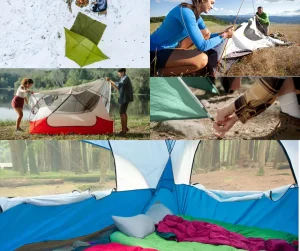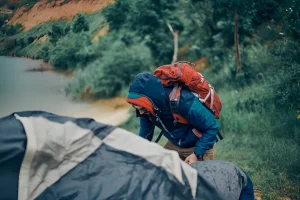Introduction
Who hasn’t experienced the thrill of setting up their first tent? For many, it’s a rite of passage into the world of camping. I remember my first attempt vividly—it was a mix of excitement and frustration. The poles seemed to twist and turn in every direction except the one I wanted, and the fabric stubbornly refused to cooperate. Hours later, I managed to get it standing, albeit with a little help from a friend and a lot of patience. The result was a tent that leaned precariously to one side, but it was ours, and it was home for the weekend.
Set up a tent is more than just a practical skill; it’s the first step in creating a safe and comfortable shelter that will protect you from the elements. A well-pitched tent can make all the difference between a memorable camping trip and a disaster. While it might seem daunting at first, setting up a tent is a skill that can be mastered with practice and the right guidance.
In this article, we’ll walk you through a detailed, step-by-step guide on how to set up a tent. By the end of it, you’ll be pitching like a pro, ready to take on your next adventure with confidence.
Camping has become increasingly popular, and with good reason. It offers a chance to disconnect from the hustle and bustle of daily life and reconnect with nature. However, to fully enjoy this experience, it’s crucial to have a solid foundation—literally. Knowing how to set up a tent is one of the most fundamental camping skills you can acquire.
So, lets dive in and explore the world of tent setup together! Whether you’re a seasoned camper or just starting out, this guide will provide you with the knowledge and confidence you need to create a comfortable home away from home.
Essential Tent Components and Terminology
Understanding the different types of tents and their components is crucial for a successful camping experience. Whether you’re a seasoned camper or a novice, knowing what each part of your tent is and how it functions will make setting up your tent much easier and less stressful.
Common Types of Tents
- Dome Tent: This is one of the most popular types of tents due to its simplicity and durability. Dome tents have a freestanding design with poles that create a dome shape, providing excellent protection against the elements.
- A-Frame Tent: Named for its A-shaped structure, this classic tent design is known for its stability and ease of setup. A-Frame tents are a great option for those who prefer a more traditional camping experience.
- Tunnel Tent: These tents have a tunnel-like shape and are often longer, making them ideal for groups or families. They are aerodynamic, which can be beneficial in windy conditions.
- Geodesic and Semi-Geodesic Tents: These tents have a more complex pole structure that creates a strong and stable shape. They are excellent for harsh weather conditions and are often used by serious campers.
Tent Components
| Component | Description |
|---|---|
| Tent Body | The main fabric structure where you sleep, typically with doors and windows for ventilation. |
| Rainfly | An additional waterproof layer placed over the tent to protect against rain. |
| Poles | Metal or fiberglass rods that provide the tent’s structure. Aluminum poles are durable, while fiberglass poles are lighter. |
| Stakes | Metal or plastic spikes used to secure the tent firmly to the ground. |
| Guy Lines | Ropes or strings that connect the tent to the ground or other anchors to stabilize it, especially in windy conditions. |
| Footprint/Ground Cloth | A protective layer placed under the tent to shield it from moisture and abrasion. |
| Peak Height | The tallest interior point of the tent, affecting interior comfort and mobility. |
| Floor Dimensions | Measurements of the tent’s base, indicating interior space and capacity. |
| Seams | Stitched areas where fabric is joined together; proper sealing is essential for waterproofing. |
| Vestibule | A covered area outside the tent entrance, useful for storing wet gear. |
Key Terminology Explained
- Peak Height: This refers to the highest point inside the tent, which determines headroom and comfort. A taller peak height allows for easier movement and a more comfortable living space.
- Floor Dimensions: These measurements indicate the size and capacity of the tent’s interior. They help determine if the tent can comfortably accommodate you and your gear.
- Seams: The seams are where the fabric of the tent is sewn together. Properly sealed seams are crucial for preventing water from entering the tent during rain.
- Vestibule: This is a covered area outside the entrance of the tent, providing a dry place to store boots, jackets, and other gear.
There is a full review on which is the best tent for you, check it out here.
Personal Opinion
Understanding the components and terminology of your tent is not just about knowing how to set it up; it’s about ensuring your safety and comfort while camping. Imagine being in the middle of a camping trip and not knowing how to secure your tent properly. This knowledge empowers you to handle any situation that arises, making your camping experience more enjoyable and stress-free. Taking the time to learn about your tent’s parts and how they work together will make you a more confident camper and allow you to focus on what really matters—enjoying the great outdoors.
Preparing for Setup: Gear and Tools
When setting up a tent, having the right gear and tools is essential for a smooth and stress-free experience. Let’s break down what you need and how to prepare:
1. Unpacking and Inspecting the Tent
Before you start, it’s critical to unpack and inspect every part of your tent. Take out the tent fabric, poles, stakes, and rain fly. Check each pole for any bends or damage, and ensure all connectors are intact. If you find any issues, address them before heading out.
2. Laying Out Components for Easy Access
Once everything is unpacked, lay out all the components in an organized manner. Separate the poles, stakes, and other accessories. This will save you time and reduce frustration during the setup process. Place smaller items like stakes and rope in a container so they don’t get lost.
3. Gathering Necessary Tools
- Mallet or Hammer: These are indispensable for driving stakes into hard ground. A mallet is often preferred because it’s less likely to bend the stakes.
- Multi-Tool or Knife: Useful for cutting rope or tightening any loose parts.
- Extra Guy Lines or Rope: These help in securing the tent tightly and ensuring it remains stable in windy conditions.
4. Checking for Damage or Missing Parts
Always perform a thorough check to ensure no parts are missing or damaged. Use a checklist if it helps. A missing stake or a broken pole can ruin your camping trip.
5. Personal Opinion: Test Setup at Home
From personal experience, I can attest that doing a test setup at home is crucial. It helps you understand how your tent works and allows you to identify any potential issues beforehand. Plus, it builds confidence and reduces anxiety during the actual camping trip.
Step-by-Step Guide: Setting Up the Tent
Setting up a tent is a crucial part of your camping experience. Whether you’re a seasoned camper or a first-timer, following a clear, step-by-step process will ensure your tent is secure, comfortable, and ready for anything nature throws your way. Let’s dive into the detailed guide for setting up your tent like a pro!
A. Laying Out the Footprint/Ground Cloth
- Why It Matters: A footprint or ground cloth protects the bottom of your tent from moisture, dirt, and abrasion. It’s an essential step to extend the life of your tent.
- How to Do It:
- Find a flat, dry spot to lay the footprint. Avoid areas with rocks, sticks, or uneven ground.
- Unfold the footprint and smooth out any wrinkles. Make sure it’s centered and evenly spread.
B. Assembling the Tent Poles
- Understanding Tent Poles: Most tents come with color-coded poles that match specific corners or sleeves on the tent. Always refer to the manufacturer’s guide if you’re unsure.
- How to Assemble:
- Step 1: Attach the pole segments together. Most poles are connected by elastic cords that allow them to snap into place. Listen for the “click” sound.
- Step 2: Match the color-coded poles to the corresponding sleeves on the tent. For example, a blue pole might go into the blue sleeve.
Tent Pro Tip: If you’re struggling with the poles, try assembling them at home first to get a feel for how they work. Practice makes perfect!
C. Attaching the Tent Body to the Poles
- Connecting the Poles:
- Stand the tent upright and slide the poles through the designated sleeves.
- Feed the poles into the metal grommets at the base of the tent.
- Make sure the tent stands straight and even.
- Pro Tip: Work with a partner! Having someone to hold the tent steady while you attach the poles makes the process much easier.
D. Securing the Tent Corners with Stakes
- Why Stakes Are Important: Stakes keep your tent anchored to the ground, ensuring it doesn’t blow away in the wind.
- How to Stake:
- Start with the four corners of the tent. Drive the stakes into the ground at a 45-degree angle to ensure maximum grip.
- Use a mallet to firmly press the stakes into hard soil. Avoid using rocks, as they might bend the stakes.
Tent Hack: If the ground is too hard, dig a small shallow hole for the stake before driving it in.
E. Attaching the Rainfly and Adjusting for Proper Tension
- What is a Rainfly?: The rainfly is the waterproof layer that goes over your tent to protect it from rain and wind.
- How to Attach:
- Drape the rainfly over the top of the tent, aligning the clips with the poles.
- Use the Velcro straps or hooks to secure the rainfly to the tent body.
- Adjust the tension by tightening the straps. The rainfly should be snug but not too tight.
F. Securing Guy Lines for Stability
- What Are Guy Lines?: Guy lines are ropes that attach to the tent and stakes to provide extra stability.
- How to Secure:
- Attach one end of the guy line to the tent and the other to a stake in the ground.
- Pull the line tight and stake it at a 45-degree angle. This removes any slack and keeps the tent stable.
- Repeat for all guy lines around the tent.
G. Adjusting and Tightening All Components
- Final Check: Walk around the tent and check for any loose areas or sagging fabric.
- Tightening:
- Pull the stakes tighter if necessary.
- Adjust the guy lines to ensure the tent is as taut as possible.
H. Organizing the Interior of the Tent
- Setting Up the Inside:
- Lay down a sleeping pad or air mattress for comfort.
- Unpack your sleeping bag and pillows.
- Organize your gear in storage bins or hang it from hooks inside the tent.
I. Personal Opinion: Tips for Making the Process Easier
As an experienced camper, I can tell you that setting up a tent becomes second nature over time. Here are a few tips to make your experience smoother:
- Practice at Home: Before your trip, set up your tent in your backyard. It’s a great way to learn how everything works and saves time at the campsite.
- Stay Calm: Don’t get frustrated if it takes a few tries to get the hang of it. Every tent is different!
- Pack Smart: Keep all your tent components (poles, stakes, rainfly) in a dedicated bag so they’re easy to find.
Real-World Example
I remember a camping trip where I forgot to check the weather forecast and ended up in a heavy downpour. Luckily, I had securely attached my rainfly and guy lines, and my tent stayed dry and stable. It was a valuable lesson in the importance of proper setup!
Final Thoughts
Setting up a tent is a breeze when you follow these steps. Remember, preparation, patience, and practice are key. Whether you’re going car camping or backpacking, having a secure and comfortable tent will make your camping experience unforgettable. Happy camping!
Troubleshooting Common Tent Setup Issues
Setting up a tent can sometimes present challenges, especially when conditions aren’t ideal. Here’s how to tackle some common issues:
A. Dealing with Strong Winds During Setup
- Use Guy Lines Effectively: Ensure all guy lines are securely attached to stakes driven into the ground at a 45-degree angle. This adds stability and prevents the tent from swaying.
- Stake Down Tight: Make sure all stakes are firmly in place, and consider using rocks to weigh down the tent if necessary.
- Choose a Sheltered Spot: If possible, set up your tent in a spot that offers natural protection from the wind, such as behind trees or a hill.
B. Handling Broken or Bent Tent Poles
- Carry a Repair Kit: Always bring a tent repair kit that includes a pole sleeve and some spare parts. This can help fix a broken or bent pole temporarily.
- Use Duct Tape: In a pinch, duct tape can hold a broken pole together enough to set up the tent. However, replace the pole as soon as possible.
- Avoid Bent Poles: Be careful when assembling poles to avoid bending them at awkward angles, as this can lead to breakage.
C. Adjusting for Uneven Ground
- Use Rocks or Logs: Place rocks or logs under the low side of the tent to level it out. This ensures the tent floor is even and prevents rolling or sliding.
- Dig Shallow Trenches: If the ground is severely uneven, dig a shallow trench for the lower side of the tent to create a flatter surface.
- Choose the Best Spot: Opt for the flattest area available to minimize adjustments needed.
D. Preventing Condensation Inside the Tent
- Ventilate the Tent: Open vents and windows to allow moisture to escape. Good airflow is key to preventing condensation.
- Use a Towel: If condensation forms, wipe it down with a dry towel to prevent dripping and keep the interior dry.
- Reduce Occupancy: Avoid overcrowding the tent, as more people mean more moisture from breath and body heat.
E. Repairing Minor Tears or Damage
- Gear Repair Tape: Use a durable repair tape designed for outdoor gear to patch minor tears. This tape is usually waterproof and sturdy.
- Duct Tape for Emergencies: For quick fixes, apply duct tape over the tear, though it’s best to use proper repair materials for a more lasting solution.
- Patch Kits: Many tents come with patch kits; use these for a more permanent repair once you’re back home.
I recall a particularly windy camping trip where our tent was at risk of being blown away. We quickly secured all guy lines, added extra stakes, and weighed down the corners with rocks. Despite the initial panic, our preparation paid off, and the tent held firm. It taught me the importance of being prepared and staying calm under pressure.
Conclusion
Setting up a tent is a fundamental skill for any camper, and with these steps, you’re now equipped to do it like a pro. Whether you’re on a peaceful car camping trip or an adventurous backpacking journey, a well-set-up tent is your home away from home.
A. Recap the Key Steps for Setting Up a Tent
- Lay Out the Footprint: Start with a ground cloth to protect your tent.
- Assemble the Poles: Match the color-coded poles to the correct sleeves.
- Attach the Tent Body: Slide the poles through the sleeves and stand the tent upright.
- Stake It Down: Secure the corners and sides with stakes to keep the tent stable.
- Attach the Rainfly: Ensure it’s snug and properly clipped for weather protection.
- Tighten Everything: Pull guy lines tight and double-check all components.
Setting up a tent isn’t always easy, especially for beginners. Practice at home before your trip, and don’t get frustrated if it takes a few tries to get it right. With time, you’ll become faster and more confident.
Camping is about more than just setting up a tent—it’s about connecting with nature, spending time with loved ones, and creating unforgettable memories. Don’t let setup challenges distract you from the adventure!
There’s a sense of accomplishment in knowing your tent is secure and ready for whatever the weather brings. A well-set-up tent is your safe haven in the wild—a place to rest and recharge for the next day’s adventures.


